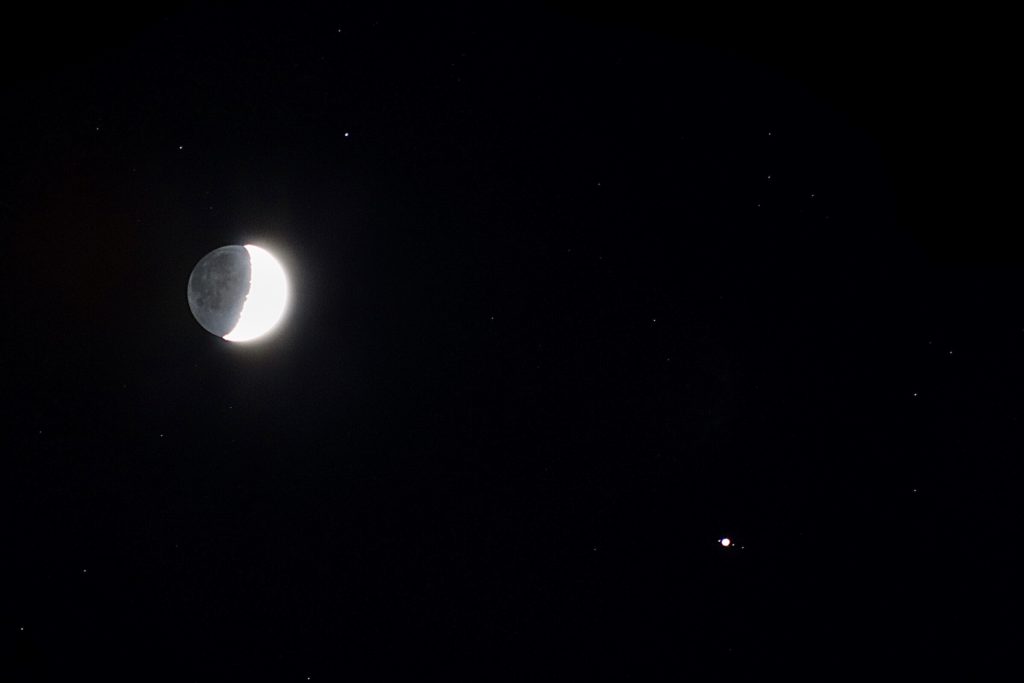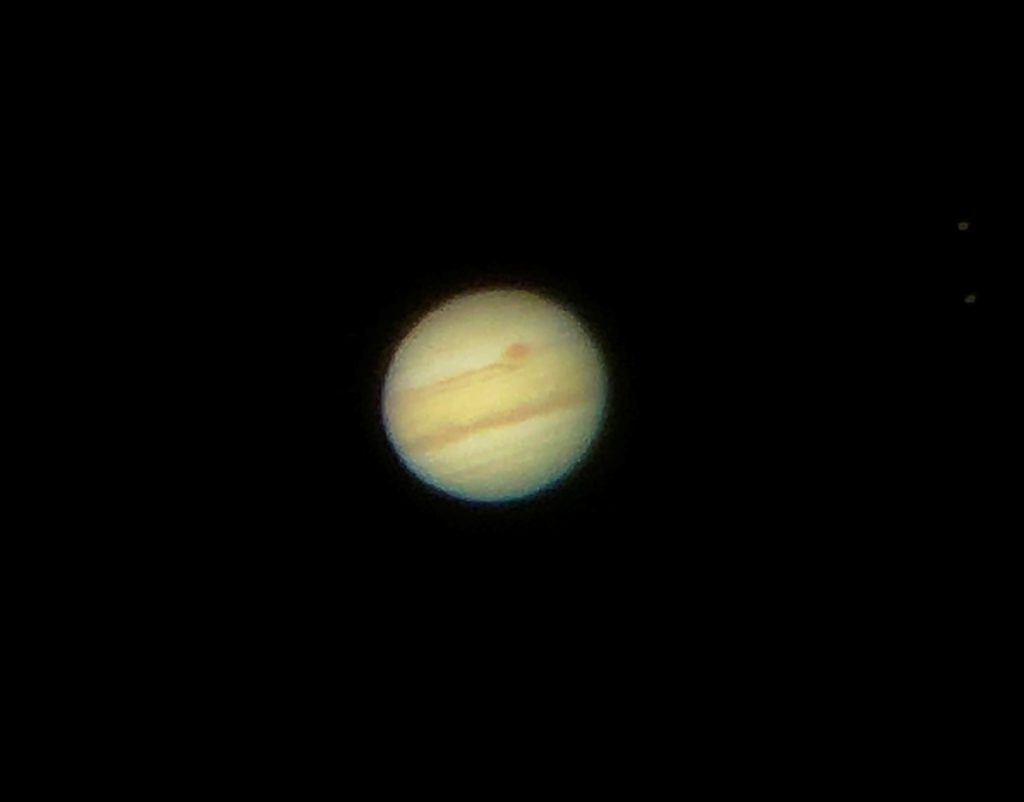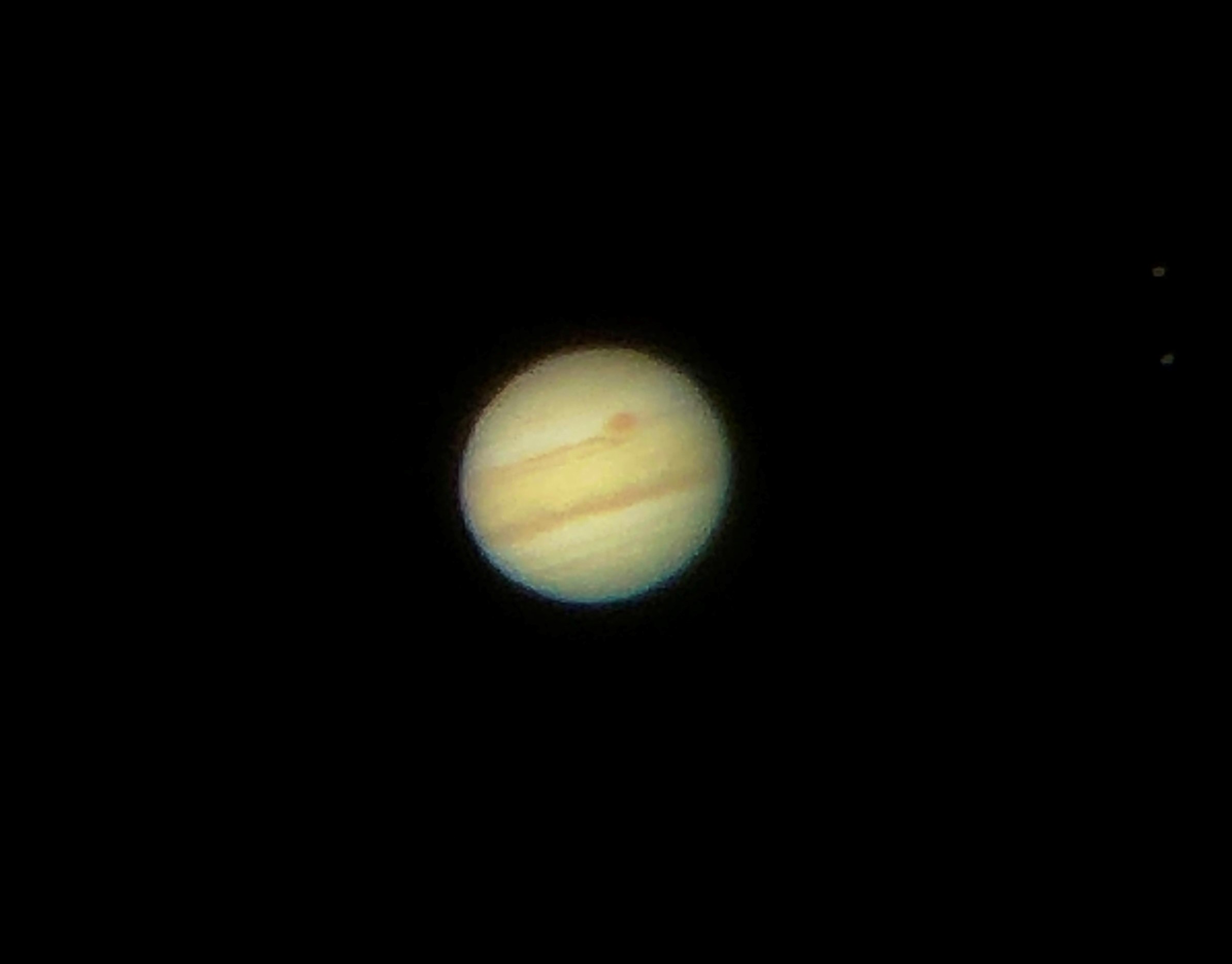We have all seen the incredible photos of the planets in our solar system taken by the Hubble Telescope in stunning detail.
One of Hubble’s more recent images not only clearly shows the bands on Jupiter, but also captures new storms raging on the surface of the massive gas giant.
Hubble Captures Crisp New Portrait of Jupiter’s Storms | NASA.
One of the major advantages Hubble has relative to other telescopes is that it takes its photos from space, beyond the confines of Earth’s turbulent atmosphere.
Seeing the photos taken by the Hubble Telescope may have you wondering what Jupiter looks like when it’s observed from Earth.
The answer to that question sort of depends. I will explain why and show you some example photos in this post.
Table of Contents
Jupiter with the naked eye
Asking what Jupiter looks like from earth is kind of like asking what LeBron James looks like from the Staples Center.
If you’re sitting in the nosebleed section (which we all are relative to the Hubble telescope), you could certainly see LeBron James with the naked eye but not in very much detail.
Much like the basketball star from the cheap seats, to the unaided eye Jupiter will look like nothing more than a very bright star in the night sky.
Since most of us don’t have court side seats at the Lakers, or access to a telescope floating in space, we can’t very well get any closer to what we are looking to observe.
The other option to get a closer view is through relatively common forms of magnification.
As it turns out it’s not very difficult to get your hands on a pair of binoculars, or a zoom camera lens to get a closer view or a photo of the basketball court.
While we won’t have the same advantage as Hubble, it’s quite easy to purchase a telescope that will still provide amazing views of Jupiter.
Jupiter with a DSLR, through a 300mm Kit Lens
Ideally you would want a very high level of magnification to get a great view of the surface of Jupiter, but not everyone owns a telescope.
DSLR cameras do commonly come in kits however, and I am willing to bet that a 75-300mm zoom lens is sitting in many people’s camera bag right now.
When you get to this level of magnification, it’s important to put your camera on a tripod. At 300mm every shake, jitter or vibration is amplified tenfold compared to a wide-angle camera lens.
I would also recommend putting the camera in manual mode, and turning features like image stabilization and autofocus off. These are often switches on the lenses themselves.
The example photo here was taken by me several years ago during a conjunction of the moon and Jupiter. The bright star-like object in the right-hand corner of the photo is Jupiter, and 3 of its moons can also be seen alongside it.

This photo would have also greatly benefitted from an ISO adjustment on the camera. Lowering the ISO would have allowed me to capture it in much better detail without washing out the surface of the planet.
Since this was one of the first astrophotography photos I ever took, I unfortunately didn’t understand that at the time.
Going back to our original analogy, aiding your view with a bit of magnification would give you a much better view of the court. It still wouldn’t be nearly as good of view as if you were sitting court side though.
What does Jupiter look like through a telescope?
Stacked Photography
I mentioned earlier that the main advantage Hubble has over telescopes on earth is that it is in space, outside of Earth’s atmosphere.
The earth’s atmosphere always has a certain level of turbulence which is measured by what’s commonly called “seeing”. It’s the same reason stars twinkle in the night sky, more so on some nights than others.
On good nights the atmospheric turbulence is low and you will have a much better view of the planets and the moon.
I’ll try to describe this the best way that I can. Have you ever seen waves of heat radiating off of hot cement in the summer time?
The distortion of the image that you see on the other side of those waves is similar to the effects of atmospheric turbulence when viewing the planets.
The way to overcome this in photography is something called lucky imaging. This is where you take thousands of pictures or more commonly frames from a video, and you stack the best ones to create one single composite image.
It’s called lucky imaging because we are literally relying on luck to capture a certain number of clear frames, based on the atmospheric turbulence at the particular millisecond that the frame is captured.
This process can produce images taken from Earth that you would literally think came from the Hubble telescope.
Here is an example of one such photo; Other examples
When you scroll down to the details, you will see comments such as “8000 frames, 30% stacked, met very good seeing”.
This is describing the exact process that I just mentioned and the results are stunning. A view this clear is not however what you should expect to see when you look through the eyepiece of a telescope.
It’s also worth noting that this was taken through a 16-inch Dobsonian telescope that will run you about $3500.
Let’s take a look at a photo that’s more representative of what you would see through an eyepiece, with a much more modest telescope.
The 6 Inch Dobsonian Telescope
In visual astronomy there’s the saying “Aperture is King”. Aperture refers to the diameter of the telescope, and the larger it is the more light it will collect.
This is much more important in visual astronomy than it is in deep space astrophotography. In deep space astrophotography you often use smaller, shorter focal length telescopes and are much more concerned about the focal ratio than the aperture.
There are many different types of telescopes that you can use for visual purposes, but the best bang for your buck is a Dobsonian telescope.
As much as I’d love to have a 16 inch dob, they aren’t entirely necessary to see the details on the surface of Jupiter.
Dobsonian telescopes are basically Newtonian telescopes that sit on a particular base designed by John Dobson.
This alt az base provides a much more stable and pleasant visual experience compared to those sitting on a shaky tripod.
Moderate-sized Dobsonian telescopes are widely available from tons of different vendors, and you can even find them on Amazon. Some of the most popular names are Orion/Skywatcher, Apertura and Zhumell.
The very first telescope I ever bought was a Skywatcher Classic 150, 6 inch Dob.
I wanted to take some photos to share with friends and family but I didn’t have the slightest clue what image stacking was at the time.
I just wanted to capture a single image of exactly what I was seeing through the eyepiece of the telescope.
With my iPhone, a $20 eyepiece and a cheap cell phone holder that I ordered on Amazon, I took this image of Jupiter.
The photo that you see below is one single frame, with no editing or image stacking.
This photo is exactly what Jupiter looks like from earth, through a one of the most commonly used and readily available telescopes on the market.

Conclusion
The answer to the question “what does Jupiter look like from earth” really depends on how you are viewing it.
We can’t get any closer to Jupiter just like most people at the Staples Center can’t get court side seats to see LeBron James. Our best option to get a better view in either case is by using magnification.
There are various ways to capture Hubble-like photos of Jupiter from earth, but they involve processing thousands of frames through computer software.
They are also not representative of what you would truly see in person through an eyepiece.
You can however still get incredible views of the planets from your backyard, with much more modest and affordable telescopes.
For those that have never seen the planets with their own eyes, its truly a sight to behold.


How close the planet is to the horizon also has a huge effect on how bright it appears. When a planet is high above the horizon, you are looking through less air to see it. When a planet is closer to the horizon, you are looking through more air, and so the planet will appear dimmer than when it was higher up in the sky. Planets are also different colors! Mercury is white-ish in color and Venus is bright white. Mars is a rust-orange color. (We know, it’s called the Red Planet—what can we say? It’s orange.) Jupiter is a light tan color and Saturn is a yellow-ish tan color.